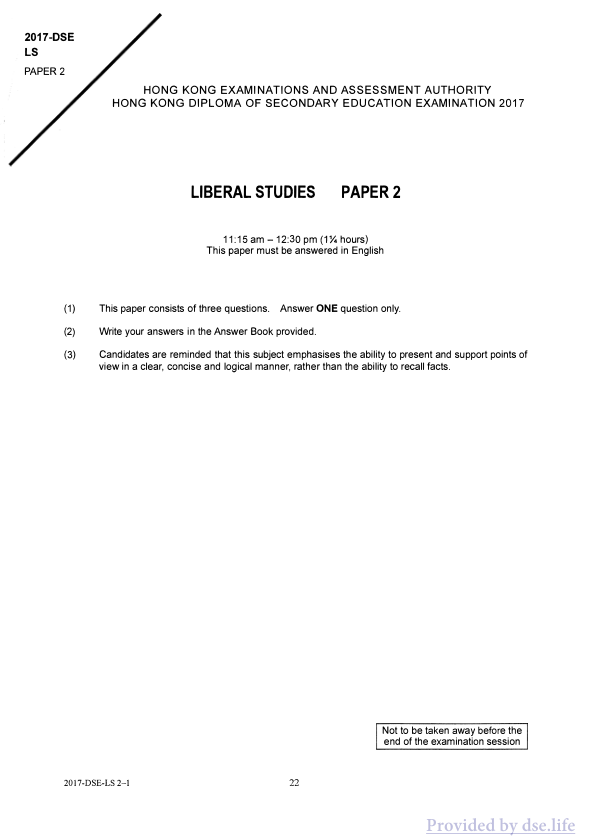2017 DSE 通识教育-LiberalStudies 真题 答案 详解
2017-05-01 dse dse 通识教育-LiberalStudies
| 序号 | 文件列表 | 说明 | ||
|---|---|---|---|---|
| 1 | 2017-通识教育-LiberalStudies-answer-zh.pdf | 16 页 | 2.04MB | 答案(中文) |
| 2 | 2017-通识教育-LiberalStudies-answer-eng.pdf | 18 页 | 4.45MB | 答案(英文) |
| 3 | 2017-通识教育-LiberalStudies-paper1-zh.pdf | 6 页 | 1.52MB | 真题 Paper 1(中文) |
| 4 | 2017-通识教育-LiberalStudies-paper2-zh.pdf | 4 页 | 1.02MB | 真题 Paper 2(中文) |
| 5 | 2017-通识教育-LiberalStudies-paper1-eng.pdf | 18 页 | 3.05MB | 真题 Paper 1(英文) |
| 6 | 2017-通识教育-LiberalStudies-paper2-eng.pdf | 4 页 | 816.60KB | 真题 Paper 2(英文) |
答案(中文)
評卷參考
本評卷參考只就各題提供一套建議的評卷要求,供閱卷員參考。不應將此視為標凖答案。只要言之成理,其他答案亦可給分。
卷一
1.(a)
建議評改準則
考生:
清楚及詳細描述資料 A 所顯示的香港華裔人士對不同少數族裔群體的接受程度的模式,例如:
- 對不同族裔群體的接受程度存在差異。一般來說,日本人獲得最高的接受程度(由 71.6% 至 92.9%),非洲人最低(由 18.6% 至 70.3%);
- 本地華人對已發展國家人士(日本人、美國人和歐洲人)的接受程度高於發展中國家人士(例如:非洲人、南亞人);
- 最能接受跟少數族裔成為朋友(最高為 92.9%,最低 70%),跟他們結婚(最高為 71.6%,最低 18.6%)的接受程度最低;
- 在涉及最親密關係的情況下,接受程度最低。本地華人較不願意私人領域內(例如:結婚)接受少數族裔群體(非洲人和南亞人分別為 18.6% 和 21.7%)等。
能適當及全面地運用所提供的資料
指出有關模式,但只利用有限資料作簡單描述;或描述該模式時忽略主要特徵;或分別描述個/列 能運用所提供的資料中部分相關的要點,但不全面 簡單描述一些數字,但部分描述或不正確 只能運用有限資料,或有時並不恰當地運用資料 沒有試作答 所答的與題目毫不相干
4
2-3
1
0
1.(b)
建議評改準則
考生:
指出及清楚解釋可能影響少數族裔青年人對他們將來在港的抱負的兩個因素;能充分理解及恰當地運用有關知識及概念;可採用部分下列或其他恰當的要點,例如:
- 人際 / 社會接受程度 / 社交圈子的影響(資料 A 及 B):香港的少數族裔青年人可能對未來生活存有夢想 / 有所計劃 / 心存慮,例如在哪裹居住、跟誰人談戀愛、是否被朋接受。非洲人和南亞人獲華人接受的整體程度最低(資料 A),或反映這些少數族裔青年人在香港交朋友(資料 B)或結婚受到限制;
- 在工作場所的接受程度(資料 A):資料 A顯示對非洲和南亞同事的接受程度较低,可能限制少數族裔青年人的就業機會和職業生涯計劃;
- 歸屬感(資料 A 及 B)/ 文化差異 / 語言障礙(資料 B):由於華人是絕大多數的族裔群體,而且中文是官方語言之一,因此中華文化是香港的主要文化。香港的少數族裔青年人可能會因為文化差異和跟絕大多數人溝通的语言障礙而對身分感到困 感(資料 B)或可能欠缺歸屬感 / 安定的感覺,因而阻礙他們
5-6
26
Provided by dse.life
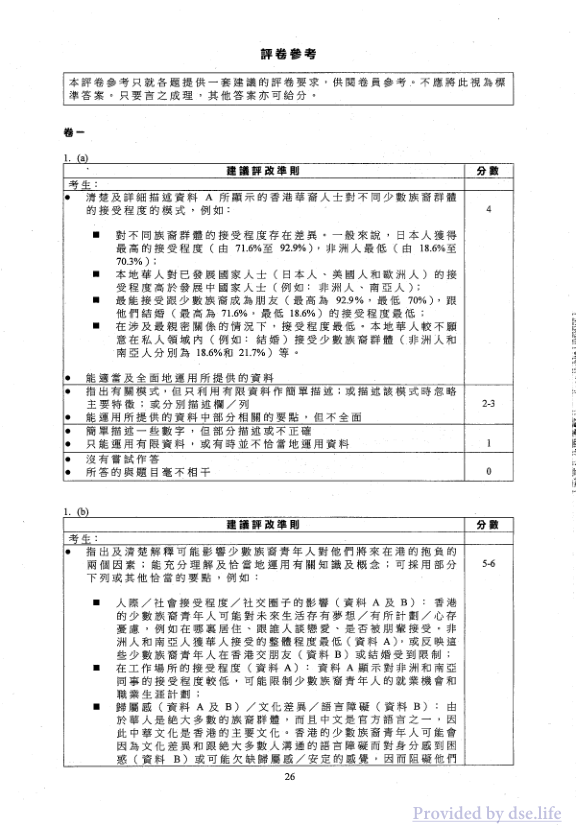
答案(英文)
Marking Guidelines
The marking guidelines will only list a set of suggested marking criteria for each question for markers' reference. They should not be regarded as sets of model answers. Alternative answers are also acceptable as long as they are reasonable.
Paper 1
- (a)
Suggested Marking Guidelines
Marks
The candidate:
describes clearly and in detail the pattern of acceptance by Hong Kong ethnic Chinese of different ethnic groups as shown in Source A, e.g.: - There were discrepancies in the levels of acceptance of various ethnic groups. Generally speaking, Japanese received the highest level of acceptance (from 71.6% to 92.9%) while Africans the lowest (from 18.6% to 70.3%); - Local Chinese showed greater acceptance of people from developed countries (e.g. Japan, America and European ones) than people from developing countries (e.g. African or South Asian ones); - It was most acceptable to be friends with (the highest 92.9% and the lowest 70%) and least acceptable to get married to ethnic minorities (the highest 71.6% and the lowest 18.6%); - The acceptance was lowest in the contexts involving the highest intimacy. Local Chinese were less willing to accept ethnic minority groups in the private sphere, e.g. marriage (18.6% and 21.7% for African and South Asian respectively), etc. 4
makes appropriate and full use of the sources - identifies the pattern but only describes it briefly, making limited use of the source; or neglects some key features when describing the pattern; or describes the percentages in the columns/rows separately 2-3 - makes use of some points of relevance in the sources, but not comprehensively - describes briefly some of the figures, but some of the descriptions may not be correct - makes use of the source in a limited manner or sometimes inappropriately 1 - makes no attempt to answer the question 0 gives an answer which is not relevant to the question
- (b)
Suggested Marking Guidelines
Marks
The candidate:
identifies and explains clearly two factors that might affect the aspirations for the future of ethnic minority youths in Hong Kong; shows an in-depth understanding and an appropriate application of the relevant knowledge and concepts; may draw upon some of the points below or any other appropriate alternatives, e.g. 5-6 - Interpersonal/ social acceptance/ influence of the social circle (Sources A and B): Ethnic minority youths in Hong Kong may have dreams of/ want to plan for/ worry about their future life, such as where to live, whom they will fall in love with, whether they are accepted by peers. The lower overall acceptance of Africans and South Asians by Chinese (Source A) may limit the ability of these minority youths to make friends (Source B) or get married in Hong Kong; - Acceptance in the workplace (Source A): Source A showed a lower level of acceptance of African and South Asian colleagues, which may limit the job opportunities and career plans of minority youths; - Sense of belonging (Source A and B)/ cultural differences/ language barrier (Source B): Chinese culture is the dominant culture in Hong Kong as Chinese are the majority ethnic group and Chinese is one of the official languages. Ethnic minority youths in Hong Kong may feel confused about their identity due to cultural
26
Provided by dse.life
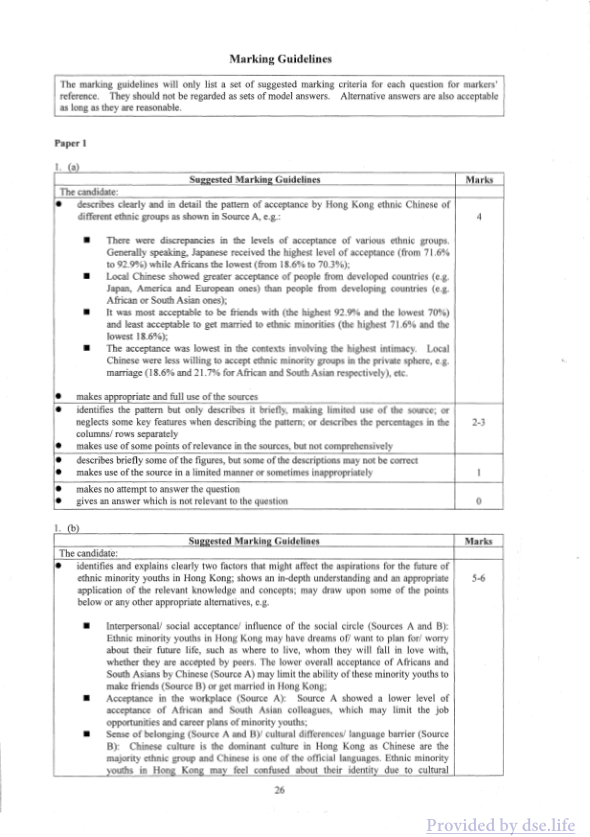
真题 Paper 1(中文)
2017-DSE 通識教育 卷一
香港考試及評核局 2017年香港中學文憑考試
通識教育 試卷一
本試卷必須用中文作答 二小時完卷(上午八時三十分至上午十時三十分)
(一) 本卷共設三題,各題全答。
(二) 試題答案薄在本試卷內。把答案寫在試題答案薄中预留的空位内。寫於本試卷内的答案將不予評閱。
(三) 不可在各頁邊界以外位置書寫。寫於邊界以外的答案,將不予評閱。
(四) 宣布開考後,考生須首先在試題答案薄第1頁之適當位置填寫考生編號,並在第1、3及5頁之適當位置貼上電腦條碼。
(五) 如有必要,可要求派發補充答题纸。每一張紙均須填寫考生編號、填畫試題編號方格、貼上電腦條碼,並用繩綁於簿內。
(六) 試場主任宣布停筆後,考生不會獲得額外時間貼上電腦條碼及填畫試題編號方格。
(七) 本科著重考核考生能否清晰、簡潔及合乎邏輯地闡述和支持其觀點,而非背诵資料的能力。
考試結束前不可 將試卷攜離試場
2017-DSE-LS 1-1
4
Provided by dse.life
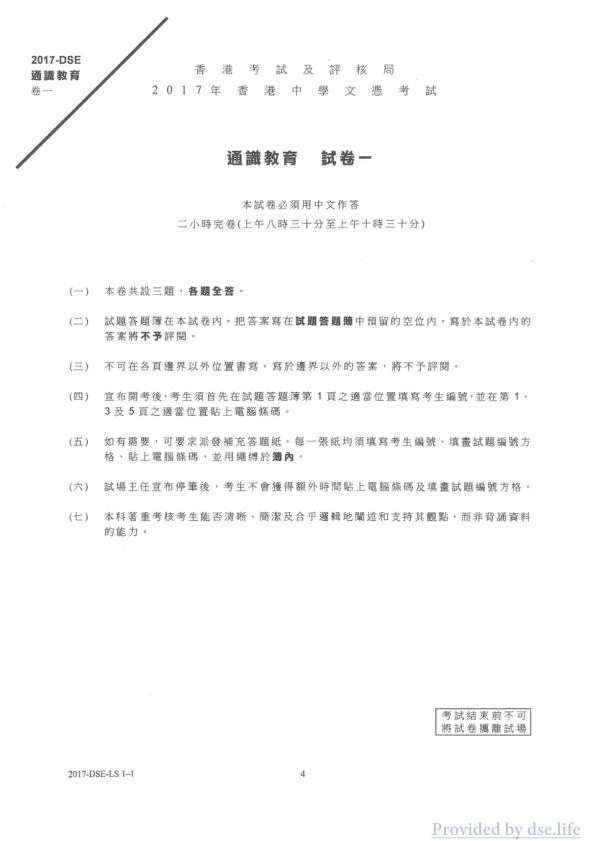
真题 Paper 2(中文)
2017-DSE 通識教育 卷二
香港考試及評核局 2017年香港中學文憑考試
通識教育 試卷二
本試卷必須用中文作答 一小時十五分鐘完卷(上午十一時十五分至下午十二時三十分)
(一) 本卷共設三題,考生只須選答一題。
(二) 把答案寫在答题簿內。
(三) 本科著重考核考生能否清晰、簡潔及合乎邏輯地闡述和支持其觀點,而非背誦資料的能力。
2017-DSE-LS 2-1 22
考试結束前不可 將試卷攜離試場
Provided by dse.life
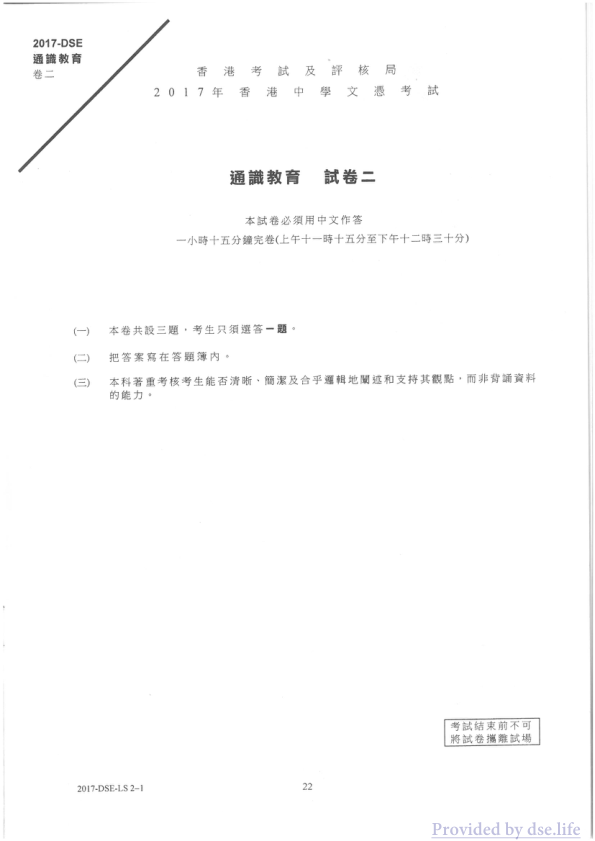
真题 Paper 1(英文)
2017-DSE LS PAPER 1
HONG KONG EXAMINATIONS AND ASSESSMENT AUTHORITY HONG KONG DIPLOMA OF SECONDARY EDUCATION EXAMINATION 2017
LIBERAL STUDIES PAPER 1
8:30 am – 10:30 am (2 hours) This paper must be answered in English
(1) This paper consists of three questions. Answer ALL questions. (2) The Question-Answer Book is inserted into this Question Paper. Write your answers in the spaces provided in the Question-Answer Book. Answers written in this Question Paper will NOT be marked. (3) Do not write in the margins. Answers written in the margins will not be marked. (4) After the announcement of the start of the examination, you should first write your Candidate Number in the space provided on Page 1 of the Question-Answer Book and stick barcode labels in the spaces provided on Pages 1, 3 and 5. (5) Supplementary answer sheets will be supplied on request. Write your Candidate Number, mark the question number box and stick a barcode label on each sheet, and fasten them with string INSIDE the Question-Answer Book. (6) No extra time will be given to candidates for sticking on the barcode labels or filling in the question number boxes after the 'Time is up' announcement. (7) Candidates are reminded that this subject emphasises the ability to present and support points of view in a clear, concise and logical manner, rather than the ability to recall facts.
Not to be taken away before the end of the examination session
2017-DSE-LS 1-1
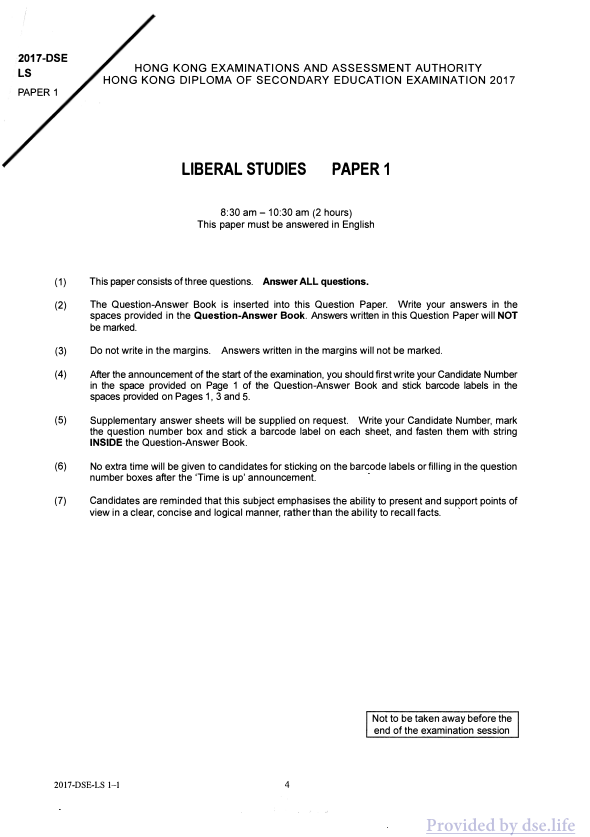
真题 Paper 2(英文)
2017-DSE LS PAPER 2
HONG KONG EXAMINATIONS AND ASSESSMENT AUTHORITY HONG KONG DIPLOMA OF SECONDARY EDUCATION EXAMINATION 2017
LIBERAL STUDIES PAPER 2
11:15 am – 12:30 pm (1¼ hours) This paper must be answered in English
(1) This paper consists of three questions. Answer ONE question only.
(2) Write your answers in the Answer Book provided.
(3) Candidates are reminded that this subject emphasises the ability to present and support points of view in a clear, concise and logical manner, rather than the ability to recall facts.
Not to be taken away before the end of the examination session
2017-DSE-LS 2-1
22
Provided by dse.life
